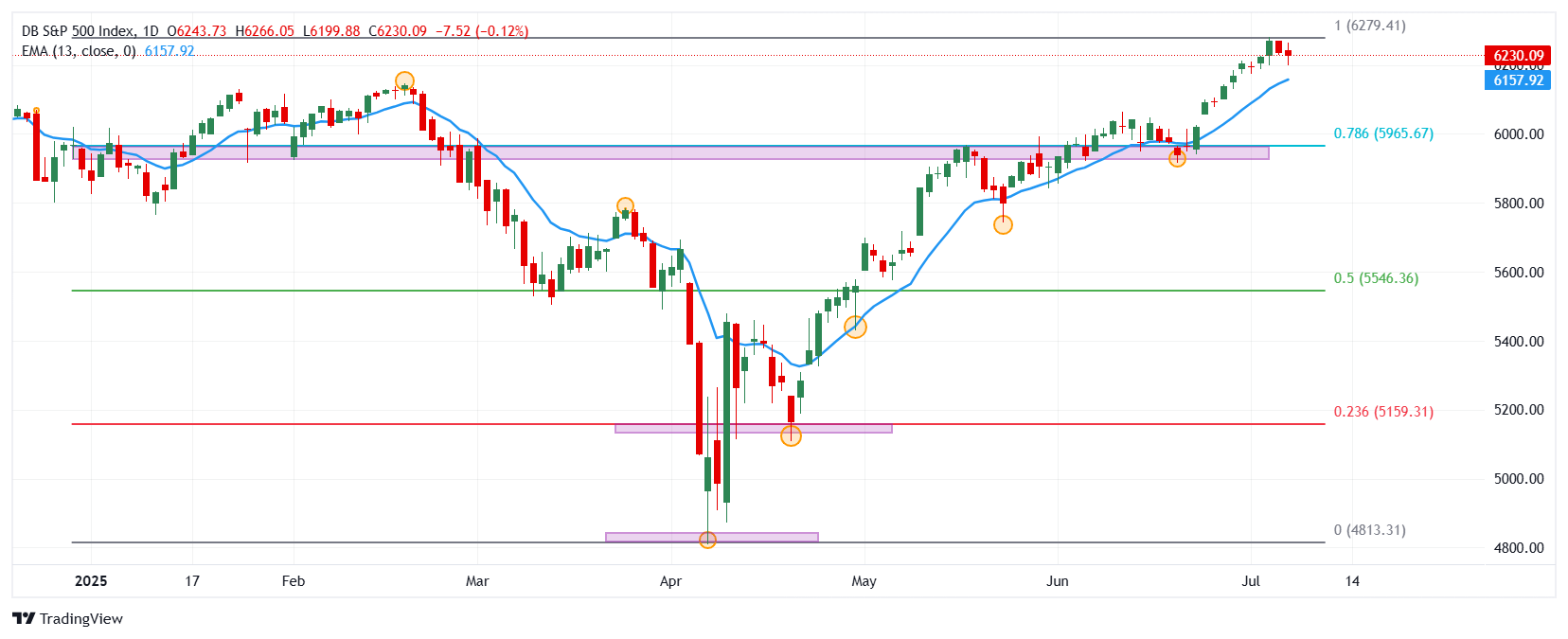- The S&P 500 share index decoced 0.12% in the day, reaching minimum of July 3 in 6,266.
- Tesla (TSLA) titles collapse 6.79% daily, reaching minimum of June 9 at 288.77 $.
- Bunge Limited (BG) shares lose 4.58% today, quoting at the time of writing about $ 74.85.
- The president of the United States, Donald Trump, imposes 25% tariffs on Japan and South Korea, effective as of August 1.
The S&P 500 reacted down from a daily maximum in 6,266, attracting vendors that dragged the minimum of July 3 in 6,199. At the time of writing, the S&P 500 operates over 6,230, falling 0.12% on Monday.
Donald Trump increases commercial tensions after the tariff imposition to Japan and South Korea
In the midst of a tense commercial environment, the president of the United States, Donald Trump, announced the imposition of 25% to all import assets from Japan and South Korea, as of August 1. He stressed that both nations have carried out unfair practices, including high import taxes and non -tariff barriers.
In the same tonic, the president threatened with the application of an additional 10% tariff to any country that is aligned with the “anti -American policies” of the BRICS block.
On the other hand, the shares of Tesla (TSLA) have a loss of 6.79% today, visiting June 9 at 288.77 $, signing its second consecutive day upwards.
Following the bassist perspective, Bunge Limited (BG) values fall 4.58% on Monday, reaching June 12 at $ 74.83, spinning two consecutive sessions on negative terrain.
In this context, the S&P 500 goes back 7 points daily, oscillating within the range of the July 3 session in 6,230.
Levels to be considered in the S&P 500
The S&P 500 formed a short -term support given by the minimum of June 19 in 5,917. The following key support is in 5.430, given by the minimum of April 30 in convergence with the exponential mobile average of 13 periods. Upwards, we project a possible profits in 6,600, a closed number that converges with the extension to 127.2% of Fibonacci.
S&P 500 DAILY GRAPH

S&P 500 – Frequently Questions
The S&P 500 is a very often stock index that measures the yield of 500 public companies and is considered a wide measure of the US stock market. The influence of each company on the calculation of the index is weighted based on stock capitalization. This is calculated by multiplying the number of bought shares of the company for the price of the action. The S&P 500 index has achieved impressive yields: 1.00 $ invested in 1970 would have produced a yield of almost $ 192.00 in 2022. The average annual profitability since its creation in 1957 has been 11.9%.
Companies are selected by Committee, unlike other indices that are included based on established standards. Even so, they must fulfill certain eligibility criteria, the most important of which is stock market, which must be equal to or greater than 12.7 billion dollars. Other criteria are liquidity, domicile, stock capitalization, sector, financial viability, quotation time and representation of the sectors of the United States economy. The nine largest companies in the index represent 27.8% of the stock market capitalization.
There are several ways to operate with the S&P 500. Most of the Stred Betting retail runners and platforms allow operators to use contracts per difference (CFD) to make bets on the price direction. In addition, indexed funds, investment funds and quoted funds (ETF) that follow the price of the S&P 500 can be purchased. The most ETF liquid is the ETF of the London Stock Exchange. The most ETF liquid is the State Street Corporation Spy. The Chicago Mercantile Exchange (CME) offers futures contracts on the index and the Chicago Board of Options (CMOE) offers options, as well as ETF, ETF Inverse and ETF leverage.
There are many factors that promote S&P 500, but mainly it is the aggregate performance of the companies that compose it, revealed in their reports of quarterly and annual results. American and world macroeconomic data also contribute, since they influence investors’ confidence, which is positive drives profits. The level of interest rates, set by the Federal Reserve (FED), also influences the S&P 500, since it affects the cost of credit, which is largely depending on many companies. Therefore, inflation can be a determining factor, as well as other parameters that influence the decisions of the Federal Reserve.
Source: Fx Street
I am Joshua Winder, a senior-level journalist and editor at World Stock Market. I specialize in covering news related to the stock market and economic trends. With more than 8 years of experience in this field, I have become an expert in financial reporting.







